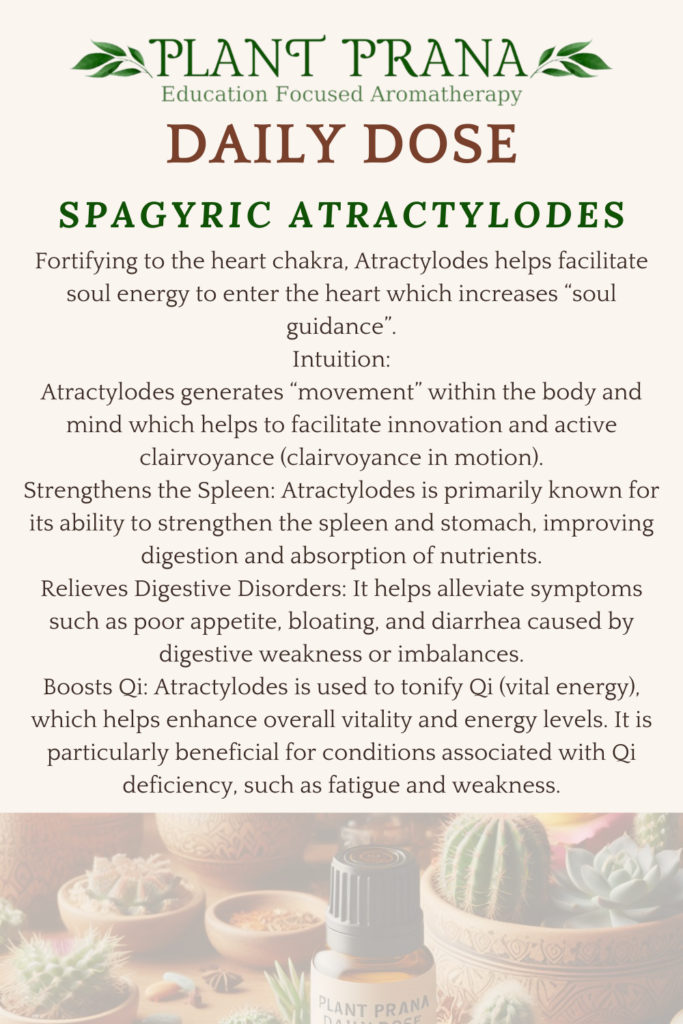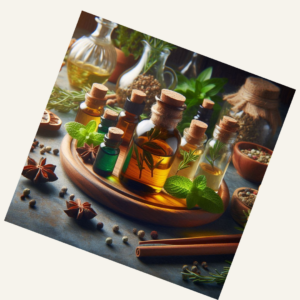Spagyric Atractylodes Tincture
Ingredients:
Atractylodes (Atractylodes macrocephala), also known as Bai Zhu in traditional Chinese medicine (TCM), is a herb with various therapeutic properties.
Heart Chakra:
Fortifying to the heart chakra, Atractylodes helps facilitate soul energy to enter the heart which increases “soul guidance”.
Intuition:
Atractylodes generates “movement” within the body and mind which helps to facilitate innovation and active clairvoyance (clairvoyance in motion).
Strengthens the Spleen: Atractylodes is primarily known for its ability to strengthen the spleen and stomach, improving digestion and absorption of nutrients.
Relieves Digestive Disorders: It helps alleviate symptoms such as poor appetite, bloating, and diarrhea caused by digestive weakness or imbalances.
Boosts Qi: Atractylodes is used to tonify Qi (vital energy), which helps enhance overall vitality and energy levels. It is particularly beneficial for conditions associated with Qi deficiency, such as fatigue and weakness.
Promotes Fluid Elimination: The herb has diuretic properties that help promote the excretion of excess fluids from the body, which can be beneficial for managing edema and fluid retention.
Enhances Immunity: Atractylodes is thought to support immune function by improving overall health and strengthening the body’s resistance to illness.
Reduces Inflammation: The herb possesses anti-inflammatory effects, which can help manage conditions characterized by inflammation, such as arthritis and other inflammatory disorders.
Balances Body Moisture: In TCM, Atractylodes helps regulate moisture in the body by drying dampness. This is useful for symptoms related to damp accumulation, such as heaviness and swelling.
Enhances Vitality: By supporting digestion, Qi, and fluid balance, Atractylodes contributes to overall well-being and helps maintain balance in bodily functions
Spagyeryor spagyric medicine, is a branch of alchemical tradition that focuses on the preparation of remedies and substances using alchemical processes. The word “spagyric” comes from the Greek terms “spao” (to draw out) and “ageiro” (to gather), reflecting the method’s core principles of separation, purification, and recombination. Here’s an overview of its definition, aspects, and mechanics:
Definition
Spagyery involves the extraction of quintessences from plants and minerals through alchemical distillation and fermentation techniques. This practice aims to harness the spiritual and healing properties of substances by separating and recombining their essential components.
Aspects
Philosophical and Spiritual: Spagyery is deeply rooted in Hermetic philosophy, which posits that everything in the universe is interconnected and that true knowledge comes through the synthesis of spiritual and material insights.
Healing: It is considered a form of holistic medicine, intended not just to treat physical ailments but to align the body, spirit, and soul, fostering overall well-being.
Transformation: A key aspect is the transformation of raw materials into purified substances, which is seen as a parallel to personal and spiritual refinement.
Mechanics
Separation: The first step in spagyric processing involves separating the plant or mineral into its three basic principles—salt (body), sulfur (soul), and mercury (spirit). This is typically achieved through processes like fermentation, distillation, and extraction.
Purification: Each component is then purified to rid it of impurities and enhance its inherent qualities. This step is crucial for concentrating the therapeutic aspects of the substance.
Recombination: Finally, the purified components are recombined in a specific way to produce a spagyric essence. This essence is believed to be more potent than the sum of its parts due to the energetic and spiritual enhancements gained through the alchemical process.
Alchemical Explanation of body, soul, and spirit
Body (Salt): In alchemy, the body represents the physical form of a substance. It is associated with the element of salt, which symbolizes solidity, stability, and permanence. The body contains the material or tangible essence of a substance, which can be manipulated or transformed through alchemical processes.
Soul (Sulfur): The soul is associated with sulfur and represents the life force or the individual essence that animates the body. It is often considered the seat of emotions and individual personality in alchemical terms. Sulfur in alchemy symbolizes combustibility and volatility, qualities that are metaphorically linked to the dynamic and ephemeral aspects of the soul.
Spirit (Mercury): Spirit, linked to mercury (also known as quicksilver), represents the mind and the divine spark within. It is the mediator between the soul and the body, acting as a bridge that connects the high (spiritual) and low (material) realms. Mercury in alchemy is characterized by fluidity and changeability, embodying the transformative and transmutative power inherent in all substances.

